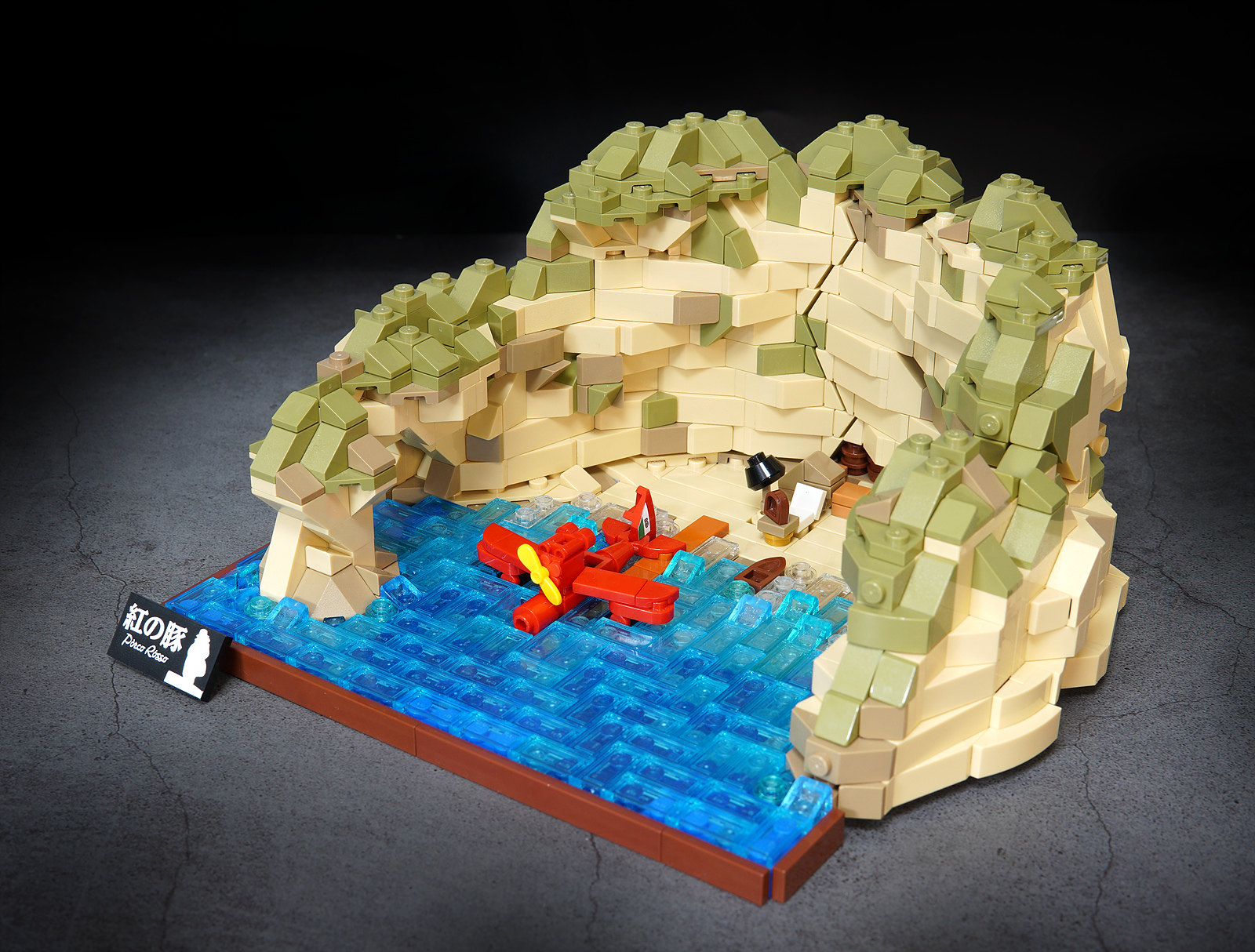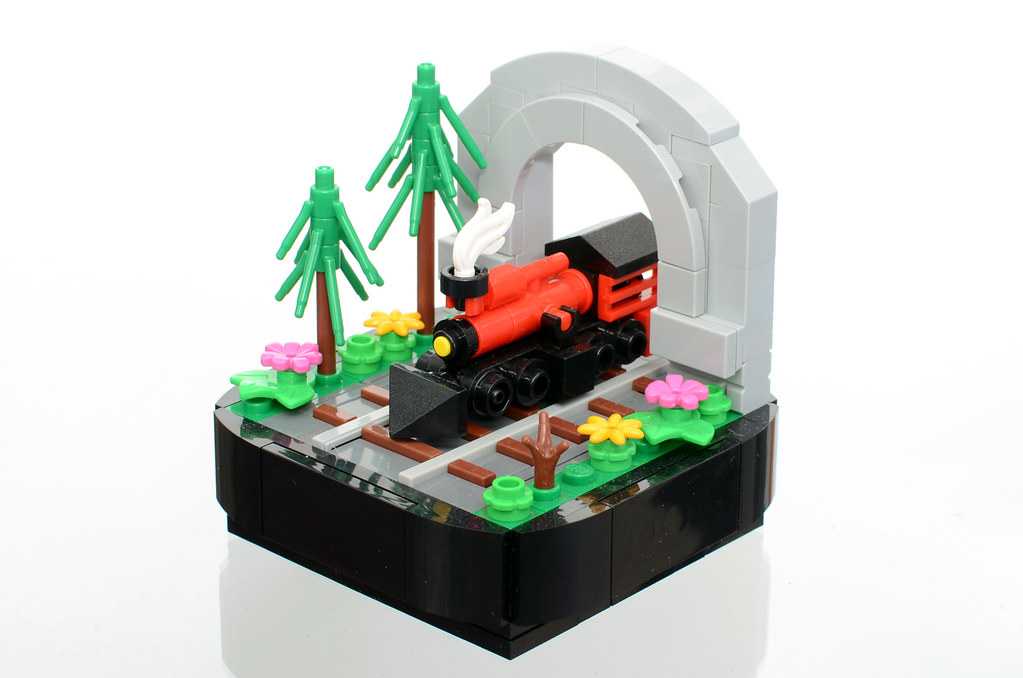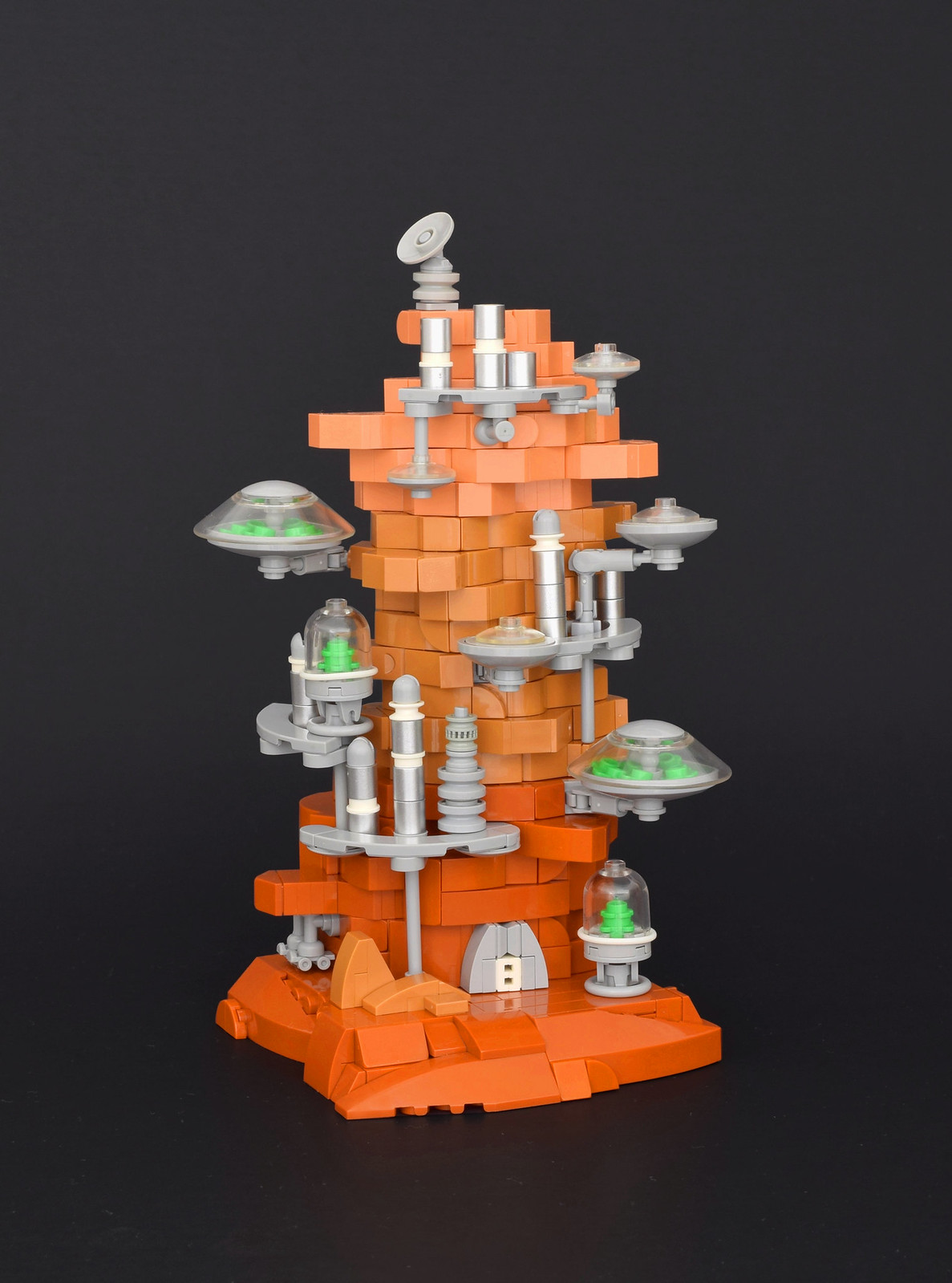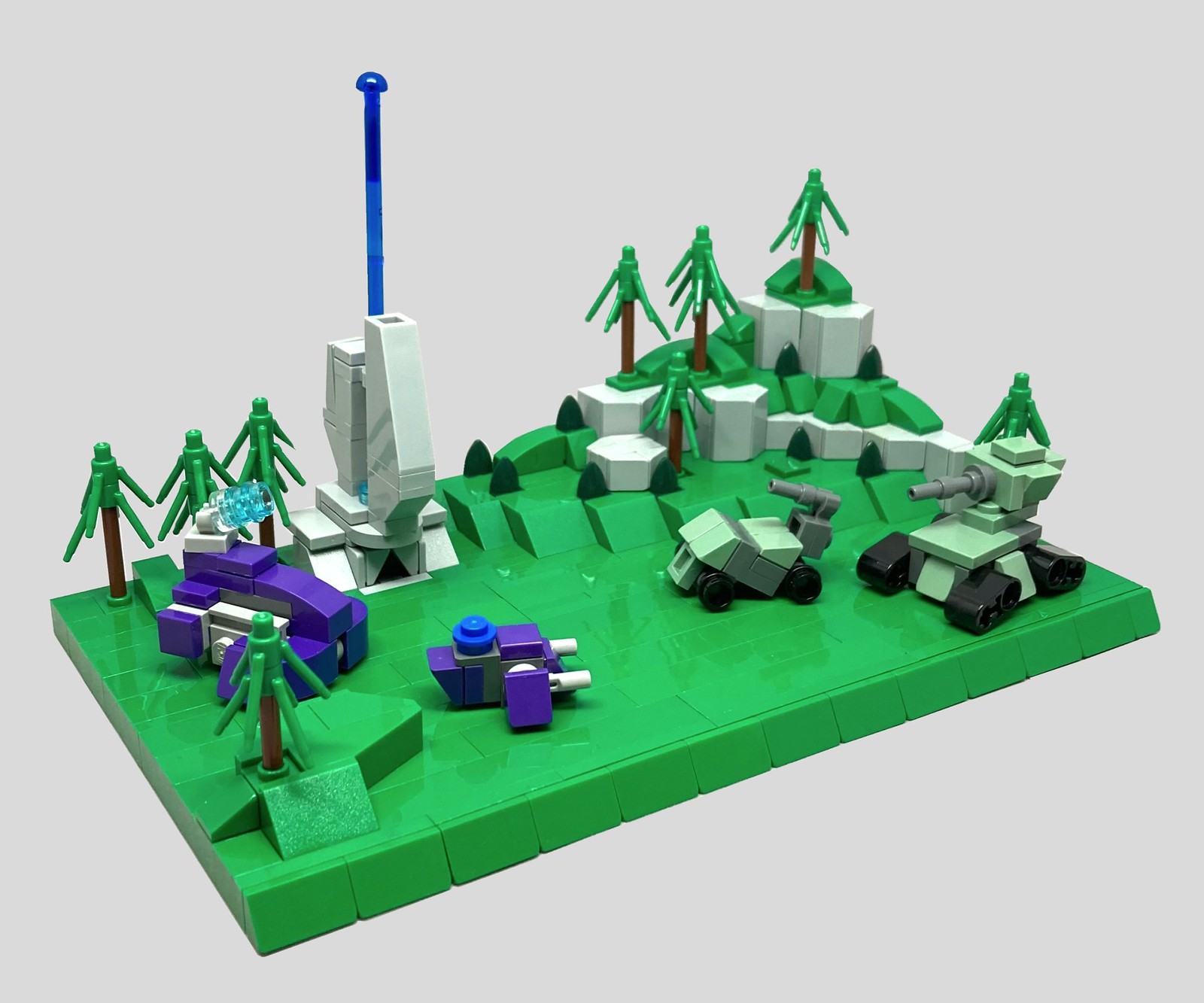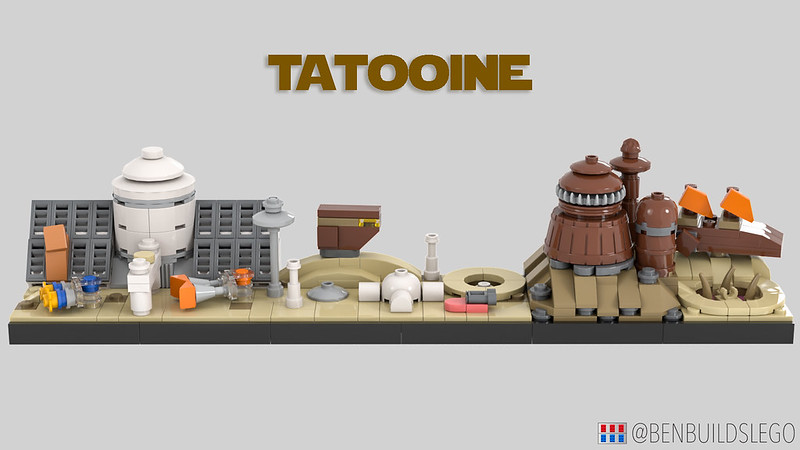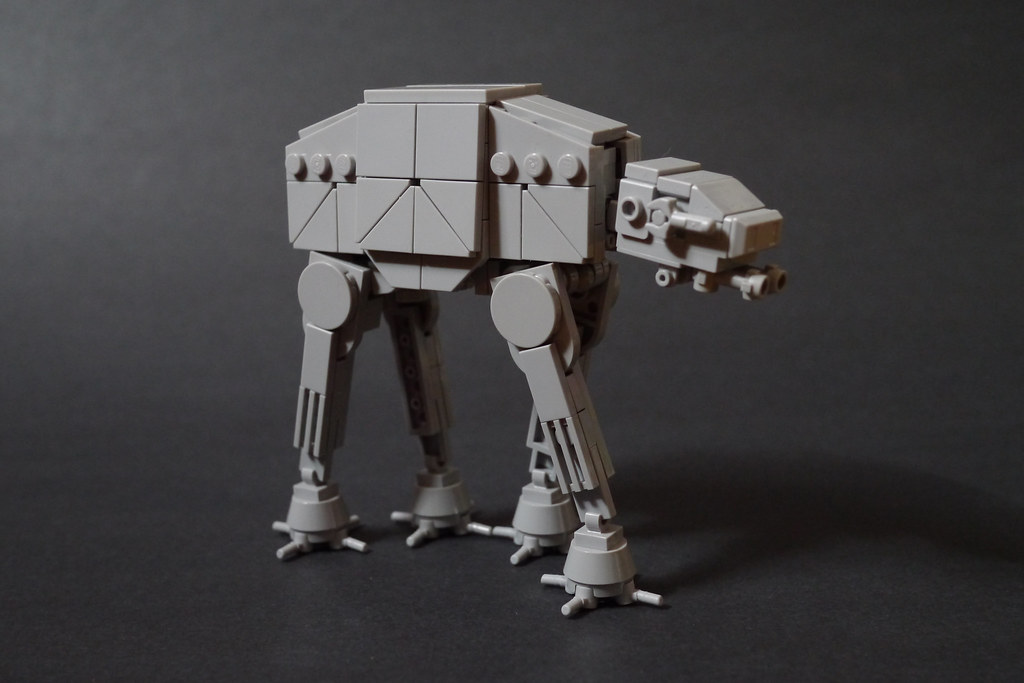Check out this excellent LEGO microscale cove built by Flickr user Pixeljunkie. The heavy use of slopes laid upon their sides provides an organic, rocky backdrop for a tiny beach scene. But it’s not just any beach! This is the hideout of Porco Rosso, the Italian flying ace slash anthropomorphic pig from the Studio Ghibli film of the same name. You can see his iconic red plane, a Savoia S.21, sitting in the water. On the coast are his tent, chair, and radio, where Porco would relax between bouts with the sky pirates of the Adriatic. The shaping of the plane in such few bricks is inspired, and immediately recognizable to someone familiar with the movie. Also of note, the 1×1 plate with tooth used as a dock is some great parts usage at this scale.
Tag Archives: Microscale
The tiny mighty Dreadnaught
A builder who goes by the name of Mix the Brix proves you don’t need a shipyard full of LEGO pieces to build an awesome battleship. This tiny model is good enough to show off the superstructure and an impressive array of cannons. I mean, check out those billowing smokestacks! Mix (can I call you Mix?) says this is their first military build and it also seems to be their first time being featured on The Brothers Brick. With wee builds this amazing, we might have to keep an eye out for whatever they may do next.
Tiny steam engine bursting with charm
Using a certain seed part as a focal point for a build can be challenging but in a good way. Constraints can fuel creativity… like in this clever little train by Thomas Gion that uses a particular Technic connector for the center of the steam engine. And while this is a great part usage, my eye was drawn to the genius use of sideways tiles inserted into the base to form the rails and slats for the train tracks. The simple stone arch and landscape round out this small but mighty model.
A tiny tyrannosaur terrorizes these tourists in a fan’s recreation of Jurassic World 76956 T-Rex Breakout
Just yesterday, LEGO released news of some new sets based on the Jurassic Park/World franchise. Inspired by the largest of the new sets, 76956 T-Rex Breakout, Nick Sweetman gave himself just 30 minutes to recreate it as best he could with the parts he had on hand, complete with a tiny T. rex. The result is a fabulous microscale recreation of a scene that should be recognizable to any fan of the original Jurassic Park film. Do you remember that scene where Hammond and Dr. Sattler are eating ice cream, and he talks about that flea circus he opened? That probably resulted in a similar scene about this size. Seriously, I bet everything that guy touches ends up in chaos…
If termites lived on Mars
Maybe it’s the choice of dark orange and nougat that made me think of Mars when I saw this microscale build by Jake Hansen, and maybe the tall chunky shape reminded me of termites, but whatever the inspiration behind this model, the part usage is off the charts. One of my favorites is the older wheel axle holder attached to the upside-down steering wheel. The chrome cylinders, as well as the many stacked gears, create interesting textures when combined with multiple sizes of wheel rims.
St. Basil’s Cathedral is bursting with colour
Koen Zwanenburg has built this incredible recreation of the iconic Russian cathedral. The dark orange with hints of teal are the most prominent colours in the structure, however, it is the spires that really draw in the eye. Each has its own unique colour scheme and design from jagged blocky shapes to smooth flowing textures. Koen has found inventive ways to represent the swirling patterns of the spires as green minifigure arms are even used in one of the peaks.
Round the back of the display, horned tendrils portray more of the complex designs of the spires. After looking at the building for some time, the structure shares some similarities with gingerbread houses, mainly thanks to the white trim and vibrant colours used in this creation.
Spirited Away bathhouse recreated from LEGO bricks in intricate detail
In the Studio Ghibli animated classic Spirited Away, a sense of wonder and magic infuses just about everything. Marcin Otręba takes us on a trip to a LEGO recreation of the iconic bathhouse, and it’s every bit as wonderous. From the graceful curve of the bridge to the spot-on color choices and complex tiling in the walls, this microscale reproduction is very true to the original. But, like in the film, there’s more here than you might first see. Keep reading to discover some of the secrets!
A little slice of Zeta Halo in the palm of your hand
It has been a while since the last Halo game, but The wait is over, with the release of Halo: Infinite, Master chief is back, and ready for action. TBB alumni Rod Gillies crafted a little slice of the massive and partially damaged ring which is the setting for the game in spectacular detail, with pine trees, rocky ground, one of the many alien artifiacts, and even the hexagonal structures that make up the ring below and around the surface. The scene by itself would be great, but miniature versions of four vehicles from both the Banished and the Space Marines are gravy on a very tasty dish.
In the land of Mordor, where the Shadows lie
When Frodo and Sam approached Mordor, they felt a great dread about land of the dark lord Sauron. LEGO builder Hubba Blöoba has captured those ominous vibes with this fantastic microscale model of the Black Gate, where the hobbits snuck into Sauron’s wasteland. Beneath the gathering stormclouds, the eery glow from Mount Doom is excellently portrayed with a gradient of plates. The shallow depth of field used in photographing this mini model puts the tower of Barad-dûr out of focus, making the scene feel even more realistic.
Tatooine is shown through the ages in this Star Wars skyline build
This fantastic digital display by BenBuildsLego depicts some classic locations from the Star Wars movies and is built in the style of the skyline architecture sets. Starting from the left, podracers are zipping past the stands, which have seats represented by tiled slope pieces (AKA Cheese Graters). This is followed by the Lars’ family homestead, with a Sandcrawler looming in the background and even an adorable version of Luke’s speeder. Jabba’s domed palace stands on a rocky cliff face, with a barrel piece portraying the building’s round base. Finally, Jabba’s sail barge hovers over the tentacles of the Sarlacc pit, ready to drop prisoners into the horror below.
Join the fight for the republic with this miniature walker from Star Wars
Tim Goddard has built this microscale model of an AT-TE vehicle from Star Wars. This walker sports the colours and logo of the 501st battalion, famed for being under the commander of Anakin Skywalker in the films. Turret cannons at the front and back use wands, from the Harry Potter theme, to represent thin gun barrels. Running alongside the walker is an AT-RT, which has the surprising detail of a screwdriver portraying its blaster cannon. The model also has some great shaping with strong sharp angles, created by the application of triangular tiles.
The only UCS AT-AT I can afford
The UCS AT-AT set is impressive: full of detail, has an accurate interior, and is a marvel of LEGO engineering when it comes to stability and articulation. But at £750, it is way out of my budget, not to mention that it wouldn’t fit anywhere in my apartment (U.K. rooms be small.) Luckily, Will (BrickGuild) Built a smaller version of the AT-AT.
This microscale Imperial Walker is instantly recognisable, and sports one of the cleanest exteriors I’ve seen on such scale. The surfaces are clean and smooth, with studs remaining only on the wedge plates. I particularly like the use of “sandwich tiles” to give the hull some paneling. Using minifig hands as the “toes” of the walker is genius. And it can be posed reasonably, tho Will had to sacrifice knee articulation. Understandably so, that would have been impossible for a model this small without making the legs too clunky.
